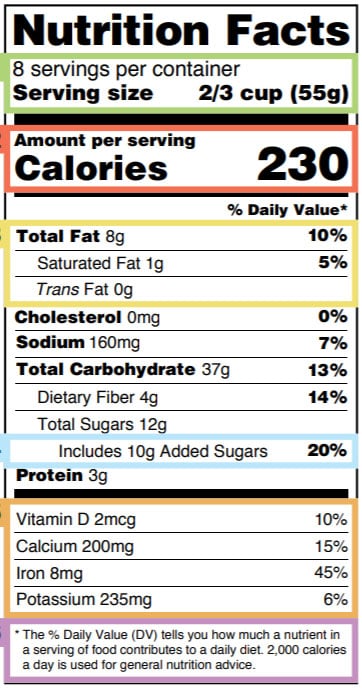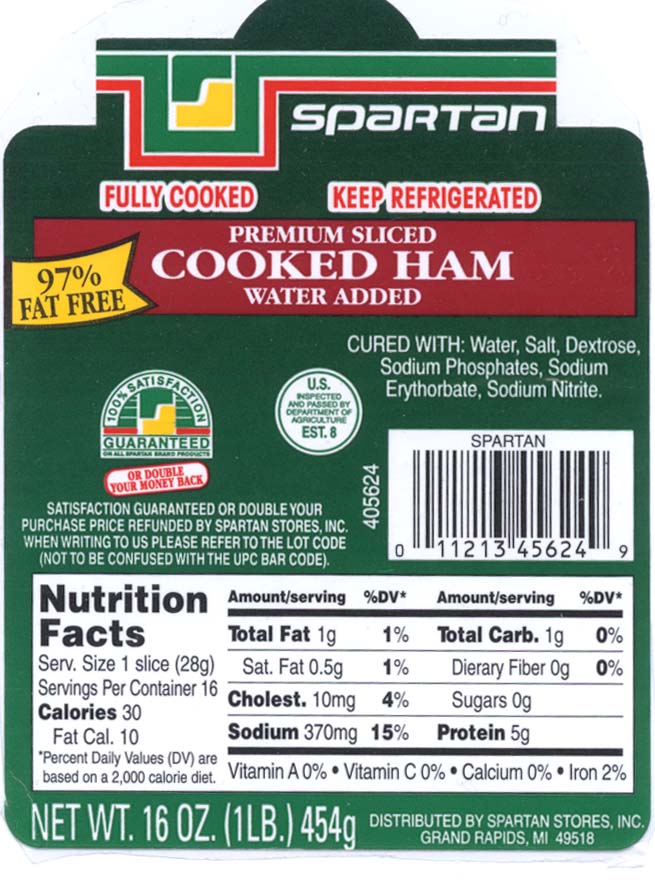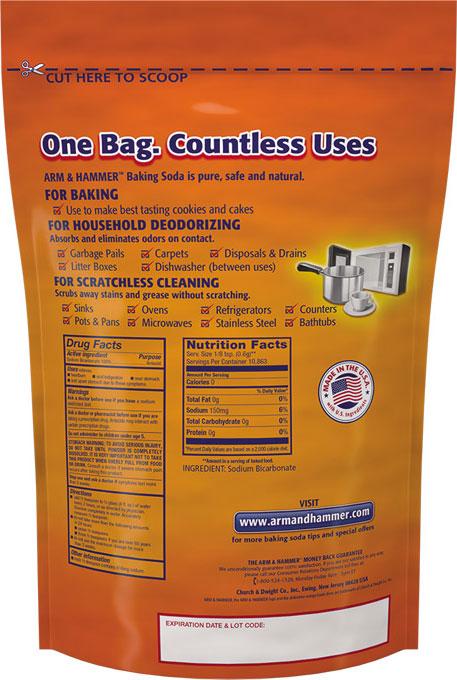39 dv on food labels
Added Sugars on the New Nutrition Facts Label | FDA - U.S. Food and ... Labels for foods and beverages with added sugars will list the number of grams and the percent Daily Value (%DV) for added sugars within the Nutrition Facts label. Having the word "includes" before... DRV and RDI: What do They Mean? | How To Read Nutrition Labels To be able to read nutrition labels, you need to understand the lingo they use. Two major terms are DRV "Daily Reference Value," or "Daily Value" sometimes called "… and RDI "Reference Daily Intake:" see post.. DRV
Nutrition Labelling and Claims - The Canadian Sugar Institute A DV for Sugars has been introduced at 100 g, which is close to the average level of consumption of total sugars in Canada, but is not a recommended level of intake; The DV for fibre increased from 25 to 28 g (1). These values are based on a 2000-calorie reference diet and can be used to compare food products and make informed food choices.
Dv on food labels
Why do nutrition labels list 0% vitamins? What exactly do the figures on nutrition labels mean? Explanation of the Percent Daily Value. The percent Daily Value (percent DV) is a measurement of how much a nutrient in a portion of food contributes to a daily diet. You can use the percent DV to see if a serving of food is high or low in a particular nutrient. How To Read Food Labels: Understanding the Basics - Instacart Food labels list Percent Daily Values (%DV) data to provide a helpful reference point. The %DV tells you what percentage of your daily recommended intake of a particular nutrient is contained within one serving of the product. Use this information to judge whether this product is providing you with appropriate amounts of certain nutrients. › health › how-read-food-andHow To Read Food and Beverage Labels | National Institute on ... Feb 24, 2022 · The % DV information is not calculated with the unique needs of older adults in mind. Read the nutrition label as a whole to determine how a particular food or drink fits into your healthy eating pattern. Is lower % DV always healthier? If a food has 5% DV or less of a nutrient per serving, it is considered low in that nutrient. If it has 20% ...
Dv on food labels. Daily Value on the New Nutrition and Supplement Facts Labels 25.02.2022 · That means that a packaged food with 1,060mg of sodium in one serving (previously 44% DV) now has 46% DV. See below for a side-by-side comparison of the information on the original and new ... How to Understand and Use the Nutrition Facts Label | FDA - U.S. Food … 25.02.2022 · Note that these colored sections are not on the actual food labels of products you purchase. Sample Label for Frozen Lasagna. back to top . 1. Serving Information (#1 on sample label) When looking ... Food Labeling. Percentages don't add up.. | Mayo Clinic Connect No, because the label (the %DV) does the math for you! It helps you interpret the nutrient numbers (grams, milligrams, or micrograms) by putting them all on the same scale for the day (0-100%DV). The %DV column doesn't add up vertically to 100%. Instead, the %DV is the percentage of the Daily Value for each nutrient in a serving of the food. Making Sense of Food Labels | ADA - American Diabetes … Percent Daily Values (%DV) The Percent Daily Values for each nutrient are found in the right column on the label. These tell you what percent of each nutrient the food provides if you were on a 2,000 calorie per day diet. As a general rule of thumb, aim for less than 5% for nutrients you want to limit, such as sodium and saturated fat. Aim for ...
Deciphering Food Labels - Bariatric Edition | IPF If the daily value is 5% or less, it is low in that nutrient and if it has a value of 20% or above, the food is considered high in that nutrient. The percentage daily value or %DV will also help you to know and understand how nutritious a food actually is. It is based on eating 2,000 calories a day. The %DV is based on how much of a specific ... Home | Dietary Supplement Label Database (DSLD) | NIH Office of Dietary ... Use the chart to learn how many products of each supplement form are in the DSLD. To search by a specific form, click on the supplement form below. 0 10,000 20,000 30,000 40,000 50,000 Number of Labels Capsules Tablets and Pills Powders Liquids Softgel Capsules Other (e.g. tea bag) Gummies and Jellies Lozenges Unknown Bars. Food Label Reading - What You Need to Know - Drugs.com It tells you how much of your daily needs are met by one serving of this food. The %DV, is based on a diet of 2000 calories. The % numbers help you decide which foods are the best sources of nutrients, such as calcium, fiber, vitamin A, or B vitamins. Ask your caregiver to help you decide what your daily calorie needs should be. The Complete Guide to Recommended Daily Intakes, Daily Values, and ... The Daily Value (DV) builds on the RDI, but creates a number meant for everyone that can be put on the labels of food products. In short, the RDI is more specific and the DV is more general. If you are confused, don't worry, this article will clarify it for you, and give you a table with all the numbers. Table of Contents Introduction
› understanding-food-labelsUnderstanding food labels - Canada.ca Find information on food labels and how to understand them. Learn about nutrition facts tables, serving size, list of ingredients, % daily value and nutrition claims. Understanding food labels - Canada.ca Food labels, nutrition facts tables, serving size, ingredients, % daily value, nutrition claims. Services and information. Nutrition facts tables. How to use, what is in them, foods that don't have a nutrition facts table. Serving size. How to use the serving size on nutrition facts tables. List of ingredients . About list of ingredients on packaged foods, common terms used for some ... Understanding food label claims - Coshocton Tribune The "% DV" is percent of daily value based on a 2,000 calorie diet, which is average amount that most adults need. ... When a food label says "gluten free" it must contain less than 20 ppm (parts per million) of gluten as this is what the FDA recognizes as the lowest level that can be detected in foods using valid scientific analytical ... › food › new-nutrition-facts-labelHow to Understand and Use the Nutrition Facts Label | FDA Feb 25, 2022 · Overview. The information in the main or top section (see #1-4) of the sample nutrition label (below) can vary with each food and beverage product; it contains product-specific information ...
Food Labels | SpringerLink Food labels have an educational function as well as an advertising role (Frohlich 2010).The characteristics of food labels seem to influence nutrition outcomes (Roberto 2005).The extent to which consumers read food labels information affects the likelihood of healthy eating (Ollberding et al. 2011).Nutrition labeling, is considered one of several population-based approaches for improving ...
› nutritionsource › food-labelUnderstanding Food Labels | The Nutrition Source | Harvard T ... Chile implemented the Law of Food Labeling and Advertising in 2016, comprised of mandatory front-of-package (FOP) warning labels, restrictions on child-directed marketing, and the banning of sales in schools of all foods and beverages containing added sugars, sodium, or saturated fats that exceeded set nutrient or calorie thresholds. [1]
How To Read Food and Beverage Labels - National Institute on … 24.02.2022 · If a food has 5% DV or less of a nutrient per serving, it is considered low in that nutrient. If it has 20% DV or more of a nutrient per serving, it is considered high in that nutrient. Low or high can be either good or bad — it depends on whether you need more of a nutrient (like dietary fiber) or less (like saturated fat).
Dietary Fiber on the Nutrition Facts Label | ESHA Research The final rule for FDA's 2016 updates to Nutrition Facts labeling incorporates two major changes to dietary fiber that food manufacturers need to be aware of: (1) a definition of "dietary fiber" - a term that FDA had not previously defined and (2) an increase in the DRV from 25 grams to 28 grams. Dietary Fiber is a mandatory label ...
How to understand the % Daily Value on the Nutrition Labels Check if a food is high or low in an individual nutrient: As a general guide, 5% DV or less of a nutrient per serving is considered low, and 20% DV or more of a nutrient per serving is considered high. Compare Foods: %DV makes it easy for you to make comparisons. Just make sure the serving sizes of each product are the same.
What Food Labels Tell You | Smokefree The % DV tells you the percentage of each nutrient in a single serving, in terms of the daily recommended amount. If you want to take in less of a nutrient such as fat or sodium, choose foods with a lower % DV—5 percent or less. If you want to take in more of a nutrient such as fiber, pick foods with a higher % DV—20 percent or more.
Nutrition Facts Label - IFT.org - Institute of Food Technologists The Nutrition Facts Label, also referred to as the Nutrition Facts Panel, on packaged food and beverage products is intended to help consumers make informed food choices that contribute to a healthy diet. The first Nutrition Facts Label regulations were published in 1993 and launched in 1994.
Understanding Food & Nutrition Labels - Mount Carmel Blog The label's nutrient section shows you the nutrients you'll be getting by consuming that product. You can use the label to seek out foods containing more of the nutrients you want (vitamins and minerals) and less of those you may want to limit (saturated fat, sodium, and added sugars). The Percent Daily Value (DV)







Post a Comment for "39 dv on food labels"